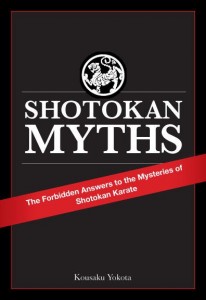Shihan Kousaku Yokota, 8thDan Shotokan Karate is releasing a new book, Shotokan Myths, which should be available from mid December.
 Firstly, I would like to say that so many other styles have spawned from Shotokan, that this book should be valuable to a far wider audience than just Shotokan Karateka.
Firstly, I would like to say that so many other styles have spawned from Shotokan, that this book should be valuable to a far wider audience than just Shotokan Karateka.
So who is Shihan Kousaku Yokota?
Yokota is an 8th Dan with 46 years of Shotokan Karate experience. He specializes in Asai ryu karate which is based on JKA style Shotokan with some White Crane Kung Fu blended in. He also practiced Okinawa kobudo (nunchaku, sai, tonfa, 3 sectional staff and 7 chain whip).
I have read some of Yokota’s articles in Shotokan Karate Magazine where he wrote about how a number of myths have developed over the years and become ingrained into Shotokan folk lore (and from there into numerous other styles of Karate and TaeKwonDo). He exposes many of these myths in an intelligent and well informed manner, explaining historical, social and practical reasons why certain practices have been introduced and how they have come to be accepted as “traditional” Karate practices, when in fact many of them are relatively new to the Karate world.
So on a blog that focuses largely on practical applications (bunkai) to traditional martial arts, why would we be interested in myths and the historical/social reason surrounded their coming into being?
Well simply put, if we know what is “real” from what is not, then we can make more informed decisions. We tend to look how to apply our katas/patterns/forms, but knowing the influences that effected them can change the application. For example, in one article in SKM, Yokota examined the myth that all kata’s should start and finish in the same place. This was never a requirement for the Okinawan masters. However, when Funikoshi took it to Japan, Karate started being taught to much larger numbers of people. There was not the same small close group of master and only a few special students. Therefore the students had to be given a way to measure their own performance. Having katas finish on the same point that they started gave a form of measure (for example, consistent stances length in both direction). To achieve this, some of the katas had to be adapted. Most Heian/Pinan kata’s today follow a capital “I” shape.  However, originally the shape of the kata was more like a double headed arrow. For example, in Kihon kata (or Heian Shodan/Pinan Nidan/Dan Gun), after doing the 3 stepping punches, instead of performing a 3/4 turn (270 degrees) it would have been a 5/8 turn (225 degrees). This made it difficult to return to original starting position, hence changing it to the “I” shape that is so familiar today. Many people interpret this movement as a throw. But knowing why the change came about, gives us the clue that we do not have to spin round quite so far to execute that same throw, actually making it a bit easier to apply!
However, originally the shape of the kata was more like a double headed arrow. For example, in Kihon kata (or Heian Shodan/Pinan Nidan/Dan Gun), after doing the 3 stepping punches, instead of performing a 3/4 turn (270 degrees) it would have been a 5/8 turn (225 degrees). This made it difficult to return to original starting position, hence changing it to the “I” shape that is so familiar today. Many people interpret this movement as a throw. But knowing why the change came about, gives us the clue that we do not have to spin round quite so far to execute that same throw, actually making it a bit easier to apply!
Other changes have been made to standardize katas to make them easier to judge in competition. Knowing these things may alter how you perceive the application that put to this movement next time you examine your kata. This is why knowing fact from myth is important to being able to practically apply your katas. It is not just an academic exercise in learning history (though this can be very interesting in its own right).
Yokota is thorough in his research and explanation. I therefore commend Shotokan Myths not only to Shotokan Karateka, but to all styles that have Shotokan in their lineage.
UPDATE:
You can now get this book from Amazon:-
In the UK
In the USA

Hi Vic
I’d never heard of that gentleman before, but good for him. At least it keeps the options open 🙂
reminds me of discovering SHOJI NISHIO a personal student of UESHIBA who stirred up the AIKIDO world by saying he was doubtful with the direction the art has taken if it could still be considered a martial art.He reintroduced many of the “old ways” of AIKI JUTSU and altered the basic practice .
@ Mark
The book is will not be available yet until mid Dec, then it will be available on Amazon. If you are on Facebook I suggest that you go to Shihan Yokota’s page at http://www.facebook.com/profile.php?id=1311281280 and add him as a friend. Then you’ll receive updates he is posting via FB.
@ Shihan Negodin
Thank you sir.
Hello there,
Where can I purchase a copy of this book in the United States?? It does not appear to be available through xlibris.com.
Thank you
I looked your site.
You have very interesting information.
Good luck in the future!